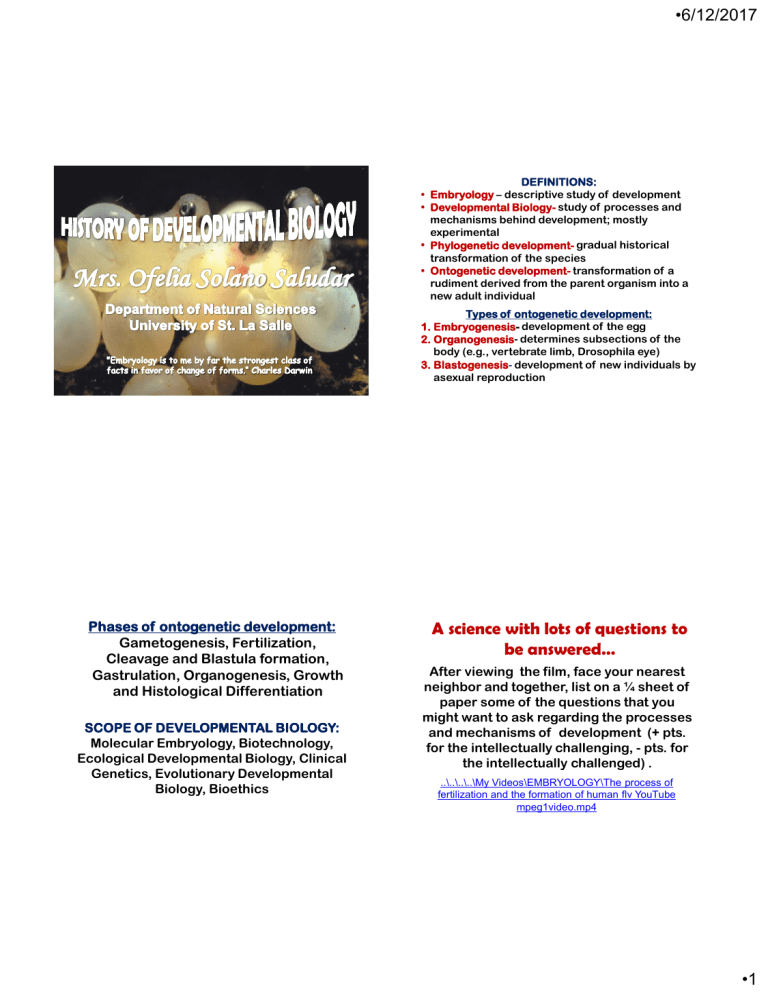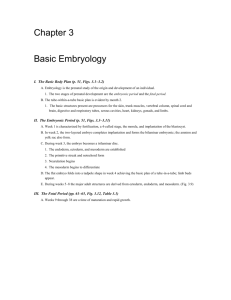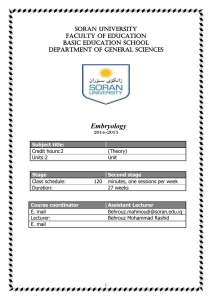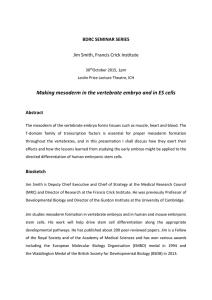
•6/12/2017 DEFINITIONS: • Embryology – descriptive study of development • Developmental Biology- study of processes and mechanisms behind development; mostly experimental • Phylogenetic development- gradual historical transformation of the species • Ontogenetic development- transformation of a rudiment derived from the parent organism into a new adult individual Types of ontogenetic development: 1. Embryogenesis- development of the egg 2. Organogenesis- determines subsections of the body (e.g., vertebrate limb, Drosophila eye) 3. Blastogenesis- development of new individuals by asexual reproduction Phases of ontogenetic development: Gametogenesis, Fertilization, Cleavage and Blastula formation, Gastrulation, Organogenesis, Growth and Histological Differentiation SCOPE OF DEVELOPMENTAL BIOLOGY: Molecular Embryology, Biotechnology, Ecological Developmental Biology, Clinical Genetics, Evolutionary Developmental Biology, Bioethics A science with lots of questions to be answered… After viewing the film, face your nearest neighbor and together, list on a ¼ sheet of paper some of the questions that you might want to ask regarding the processes and mechanisms of development (+ pts. for the intellectually challenging, - pts. for the intellectually challenged) . ..\..\..\..\My Videos\EMBRYOLOGY\The process of fertilization and the formation of human flv YouTube mpeg1video.mp4 •1 •6/12/2017 What are the major developmental processes required for the formation of a multicellular organism from a sperm and an egg? What mechanisms control development? Where are the plans or instructions for development? How are they interpreted and used? Where are the raw materials for development? How did those raw materials get to the embryo? How are they used? How do different cells and tissues know what to become? How do cells migrate? How do they know where to go? How can we control development? To what goals can we apply controlled development? Development DOES NOT happen by magic. Information and mechanisms at the cellular and/or molecular levels are needed to accomplish development. KEY PROCESSES IN DEVELOPMENT: Gametogenesis Fertilization Embryonic cell divisions –Cleavage Generation of diverse cell types: Cell fate specification; Differentiation (altered gene expression) • Tissue organization (Patterning: 3-D structure): Axis specification, Gastrulation, Organogenesis • Post-embryonic development: Metamorphosis, Regeneration, Aging • • • • •2 •6/12/2017 HISTORICAL BACKGROUND 1. Aristotle (340 BC) Do all parts of a developing organism come into existence together and simply grow larger? Is development a stepwise process characterized by progressive organization and an increase in complexity? • He observed that new structures arose progressively in embryos (e.g. blood, blood vessels, heart, blood vessels around organs). This supported epigenesis (17th century), i.e., the organism develops in a stepwise fashion from an unorganized state. • The embryo was formed from menstrual blood interacting with a male vital factor present in the semen. This creative force forms the maternal substance into embryonic body parts. 3.Caspar Friedrich Wolff (1759) • Similar to epigenetic theory but postulated that a development force inherent in the matter of the embryo directs the laying down of body parts in sequence. • He laid the foundation for the germ layer theory by showing that the material out of which the embryo is constructed is, in an early stage of development, arranged in the form of leaflike layers. 2.Bonnet & Swammerdam: (17th century) • Preformation Theory: embryonic parts are already present in the sperm or egg (animalculists or ovists) which simply grow in size in development. • Cite your counterarguments for this theory! Homunculus Descriptive and Comparative Embryology 4. Karl Ernst von Baer (1828) most coherent embryological data • Baer’s law: More general features that are common to all members of groups of animals are developed in the embryo earlier than the more special features which distinguish the members of the group. • Ex: all vertebrates (brain & spinal cord, notochord, segmented muscles, aortic arches); vs. various classes (hair, feathers, limbs) •3 •6/12/2017 5.Muller (1864), Haeckel (1868) • Biogenetic law: features that are inherited from the common ancestor of the group have an ancient origin, and develop earliest during ontogeny • Example: “Big 4” characteristics of all embryonic chordates despite differences in adult appearance • Divergent features are adaptations of the embryo to its surroundings (e.g. placenta) • However, an embryo does not “pass through” the adult stages observed in lower animals. Ontogeny does not recapitulate phylogeny; ontogeny is a shortened and modified recapitulation of phylogeny ONTOGENY RECAPITULATES PHYLOGENY? But what if a bird was THE evolutionary biologist… This bird would note that: (1) adult humans lack beaks, just as embryonic birds do (2) their adult extremities are very much alike (having not differentiated into wings and legs) just as is the case of embryonic birds (3) mammals show only the most primitive form of feather production. Therefore, birds are far more advanced than humans, and the adult human resembles the embryonic bird. •4 •6/12/2017 6. August Weismann (1883) • Germ plasm theory - every germ cell during early development receives a complete set of units of heredity (“ids” or Mendel’s “genes”) • Development involves orderly unpacking of an embryo as dictated by ids; interactions between parts make epigenetic development possible • Each egg nucleus contain discrete localized determinants which result to unequal distribution of nuclear components during cleavage • Cells cannot change their fate if a blastomere is lost (mosaic model of development) 8. H. Driesch (1891), Endres (1895), Spemann (1901), Schmidt (1903) • If cleavage cells of a sea urchin were completely separated, each develop into a whole embryo (regulative model of development). • Massive cell rearrangements and migrations precede or accompany specifications of development, allowing cells to acquire different functions. Experimental Embryology 7. Wilhelm Roux (1905) • Heat-killed one of the 2 blastomeres of a frog’s egg • Surviving cell developed half of a complete embryo • Results either support both preformation and mosaic development, or reflect use of crude techniques which possibly caused defects in the other half Analytical (modern) Embryology 9. T.H. Morgan (1919), Watson & Crick (1953) – units of heredity composed of sequence of DNA base triplets are transformed into an array of proteins, which acting partly on their own or through other chemical components, transforms the system that is an adult organism. •5 •6/12/2017 Summary Points: A FEW LAST WORDS… Development is epigenetic. Although it is regulated by the nucleus, it takes place primarily in the cytoplasm. It involves interactions between parts. The parts arise within gradient patterns or fields. Differentiation is in essence the development of the macromolecular pattern within the cell. 1. Developmental biology is not only a scientific discipline. It is also a social discourse that is deeply embedded in cultural concerns. 2. Reproductive cloning, abortion, stem cell differentiation, genetic enhancement, gene therapy, environmental estrogens, sex selection, and teratogenesis all converge on developmental biology. 3. Thus, it is crucial that we should be educated toward having more social responsibility than we have ever wanted. GROUP PROJECT: 2. Born without a cerebrum, anencephalic babies often die within a week. At the time of birth, their healthy organs could be used for transplants that could save the life of a child who might then live a long and productive life. However, by the time anencephalic babies die naturally, their organs have deteriorated. Should one save other lives by taking organs from anencephalic babies while they are still alive? 3. Who is responsible for the physically and mentally disabled and what does it mean to a woman and her family to choose not to abort? Individual families face a terrible burden of fighting for their children and fighting for the disabled, if they choose not to abort. Discuss with your group a developmental issue with social dimensions, and generate public awareness regarding your chosen topic. Ex.: 1. Consider etiology, classification, and technical aspects of surgical separation, as well as historical responses to conjoined twins, highlighting some famous 19thcentury twins. Address ethical issues concerning surgical separation, including discussions of the ethics of abortion of conjoined twins and the ethical dilemmas of killing one twin in order to save the other. •6 •6/12/2017 •7






